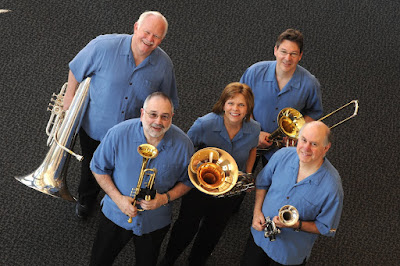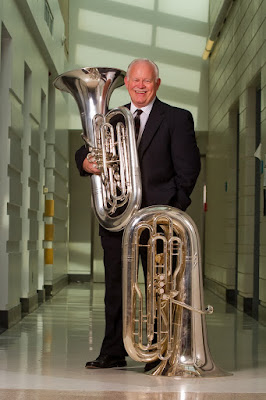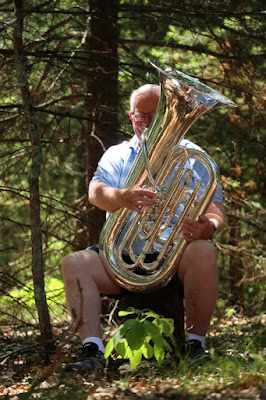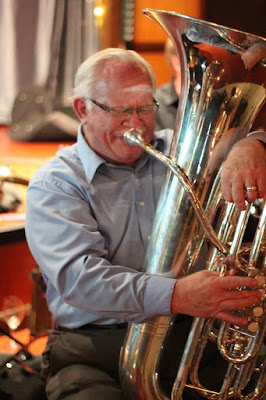Hello, for what you do not know me, or read this blog for the first time, my name is Harold Lozano Hernandez. Professor of Tuba and Wessex Artist (https://eu.wessex-tubas.com/pages/harold-hernandez ) and creator of this didactic blog which I would like to visit.
I hope this interview is to your liking and enjoy it as much as I do.
This time with a very important Tubista and recognized, I mean Marty Erikson.
Without further delay and thanks for your kind cooperation, let’s start.
· Name and surname:
Martin D. “Marty” Erickson
· What instrument / s do you use?
Willson 3400 Eb Tuba “Marty Erickson Model Big Mouth Brass BBb Tuba
· That make and model are the tools you use:
Schlipf “Mnozil Brass” Mutes: (Straight Mute and Cup Mute.)
· That manufacturer and model are the mouthpiece you use?
Erickson Signature Mouthpieces: ME-1 primarily and occasionally ME-2
Let’s talk about your education:
· When and where their studies or tuba euphonium started?
In Elementary School
· At what age?
10-11 years.
· What reasons or circumstances led him to study this instrument?
Band Director introduced/suggested the instrument.
· Who were your main teachers?
Early on it was my mother who was cornet/french horn player, as well as viola, flute and piano and a composer. First Tuba Teacher was Edward Livingston and later Dr. Leonard Falcone (at Michigan State University.)
As for his professional experience:
· Please leave us a little account of his experience as a soloist, a member of chamber ensembles, orchestra, band, etc.
· In Orchestra and / or Band:
Principal Tuba of U.S. Navy Band in Washington D.C. for 26 years. Baltimore Opera Orchestra
and extra tuba with National Symphony in Washington D.C. Played in several Chamber music
ensemble, but currently with the Lawrence Faculty Brass Quintet, the Millennium Brass and in
the Rodney Marsalis Philadelphia Big Brass. Also, Principal Eb tuba with the Brass Band of
Battle Creek (professional brass band made up of brass and percussion players from UK, Canada
and the US.) Currently principal tuba with the Fox Valley Symphony Orchestra as well.
· Solo concerts:
Travelled as soloist recently all over the US, in Brazil and Germany and was soloist with the U.S.
Navy Band for 26 years on national concert tours.
· Which uses warm-up exercises?
Buzzing and Breathing exercises, Arnold Jacobs flow studies; ballads/songs/vocalises, flexibility
exercises such as Max Schlossberg’s Daily Drills and Technical Studies, chromatic scales and all
major and minor scales throughout the range of the horn. Soft, legato playing and tonguing
exercises. Also, I included sight reading daily.
Trying other topics of interest.
· Could you give us your opinion on this and how would address this issue in the interests of education and training adapted to the necessary expertise required today?
The Spanish musicians should understand and perform the Bombardino as part of their National Heritage and to help foreign players to understand its history.
Whether or not they choose to perform the euphonium and/or tuba will depend on what their life goals are.
By learning and mastering these instruments, it will make
the musician much more “employable”—-someone able to
get a job in music.
Let’s talk about your teaching experience:
· Tell us what learning centers has taught (full-time professor, visiting professor, courses, lectures, etc.)
I’ve taught at Blue Lake Fine Arts Camp and Interlochen National Music Camp in Michigan: at the International Peace Gardens Music Camp on the border of North Dakota and Canada, at the Brass and Woodwind Course in Kalavrita, Greece, and every two years at the Deutsches.
TubaForum International Tuba and Euphonium workshop in Hammelburg, Germany. I have done
dozens of Master Classes around the world (which included a solo tour in Madrid, Vigo, Murcia,
Valencia and Sevilla, Spain), and in leading Universities in the U.S. I have soloed/lectured at
several ITECs and at the U.S. Army Band Tuba-Euphonium Conference in Washington D.C.
· How do you organize your classes and the subject in general?
Depends on the class and the needs of the event. Sometimes, I will talk about warm ups and auditions
and how to prepare for playing at the highest level. Sometimes, like in Germany, I am teaching basic
jazz improvisation and discuss scales, modes, improvisation techniques and practices.
Here I will also use Play-Along Cds and discuss creating bass lines and how to approach soloing
and more. Sometimes, I coach entire ensembles and talk about chamber music/listening/etc. This is a
LONG subject, as each presentation is geared toward what my host/school/music camp has asked me to
present.
· How long are your classes?
This varies for every situation; I have done one-hour,
two hour, three-hour, all-day, all-week and two-week teaching.
At my University, the classes last one hour and ten minutes.
· Do you think it is important that students make public
appearances during his years of training?
If so, recommend how many times it deems appropriate and
what age or course. Elementary, vocational, higher?
Absolutely; the earlier or more often this can happen, it will
build confidence in performance and an understanding of
what «works” or doesn’t work in performance.
Preparation and attitude are the keys, guided with positive goals
and support by the teachers. This should happen at all levels
as long as the appearances are appropriate for the age and
experience level of the performers.
Younger players can play for their peers or for things
like retirement homes, outdoor fairs or festivals, holiday music.
Anything that helps build confidence and models the joy of playing and the growth that is possible from
these performances.
· Is there another teacher with your same specialty in the center where you teach?
I am the only tuba-euphonium teacher
at my University but have a close
relationship and play regularly with
my colleagues at other Universities or
professionals in the area.
An important part of the course curriculum is standardized and is based on the idea that students master the repertoire alone, sometimes to the detriment of the repertoire of large groups (Orchestra and Band), when in fact, most students Tuba and euphonium will be teachers and / or members of a band and, to a lesser extent, of an orchestra in the case of Tubas.
· In your opinion, how should this problem be addressed? How important do you think is include learning and mastery of the orchestral repertoire as part of the curriculum of the course?
It is vitally important to expose the student to any and all music which can lead to a happy life as
a performer or teacher. I make sure that all of my students have a broad understanding of ALL
music; orchestral and band repertoire, chamber and solo repertoire, jazz, and music with
extended techniques.
Once the student seems to have a specific interest, we will focus more on getting deeper into the
music of that genre and develop that interest specifically. I insist on sight reading and learning as
much music of as many styles as possible.I teach the concept of what I call “HIRE” Education—I
want my students to have a happy life performing.
· Tell us what is the admission process to access your learning center:
Auditions in person or by video recording and sometimes just an audio recording.
· What it is required repertoire in the entrance exam?
Audition must prepare solo or excerpt material, or perform contrasting etudes to demonstrate
sound, technique and musicianship.
· What is an example of repertoire?
Examples of tuba solos would be: the Vaughn-Williams Concerto for Bass Tuba, Gregson Tuba
Concerto, Broughton Tuba Concerto, the Lebedev solos, etc. For the euphonium; any of the
Philip Sparke works, the Clinard Sonata for Unaccompanied Euphonium, Rhapsody for
Euphonium by James Curnow (or any of his more advanced solos). Transcriptions of classical
music of other instruments such as Bach Cello Suites, etc. Orchestra or Band excerpts may be
used as well. Can list those later if you’d like.
· How many works are required and in what format (solo, with piano, studies, etc.)?
Just two contrasting works and they can be in any format. The main thing is to have suitable material in
which to best evaluate the performer and so that the performer feels like they are “putting their best
foot forward.”
· Is there a mandatory piece? If so, what is it?
No mandatory piece.
· Approximately how long is the exam?
If it is in person, which is preferred, I spend a minimum of 45-minutes to one hour with each student.
In this way, we can learn about each other and it gives them time to relax and do their best.
I want the student feel like they are valued and leave with tools to make them better musicians.
· What aspects you value most in deciding? ¿Musicality, intonation, rhythm?
The answer is YES, all of these things, but also; does the person have not only the passion to play but a
work ethic to support that passion. Is this a nice person who will fit into my studio and add a positive
aspect to the school community and the ethos of the studio.
Positive attitude with a drive to improve and keep learning are VITAL beyond simply being able to play
well.
· If I had to choose (in a hypothetical situation), would preferably between student Tuba Euphonium or one?
If I understand the question, it is usually more difficult for a teacher whose primary instrument is Tuba
to recruit euphonium players, so I always need more euphonium players to fill our large ensembles.
About their work during the course.
· What kind of repertoire you work primarily with your students? Solo, with piano
accompaniment, chamber music, ….?
Everything: I mentioned earlier. I try to fill in any “gaps” in the students’ experience so they can
become complete players.

· What format is examining LIMIT? Solo concert, piano recital …?
Not sure what this means but I try to challenge the student to reach the highest performance level of their current ability. I want the “progress bar” to keep moving forward. Another one of my expressions (not sure how it would translate) is “Status Quo is not progress. It means that simply maintaining your current performance level does not advance your learning.
·
Does the student selects the works to play? or they are chosen by the teacher?
Early on, I have required pieces which I think will help develop the player and later on we can discuss
adding material the student would like to play, as long as there is a clear, reasonable goal and is
balanced with their lessons.
· Is there any work it deems mandatory? So what?
I have pieces I think do a great job of building confidence, particularly some unaccompanied works.
Early on for tuba that would be something like the Walter Hartley “Suite for Unaccompanied Tuba”
which is an accessible piece for most freshmen and has some interesting harmonic language and style.
The euphonium Clinard piece does the same thing.
SPEAKING OF TECHNICAL ISSUES:
· Could you give us your opinion about different concepts of sound and what characteristics define, articulation, types of instruments, literature, if the influence of language and musical tradition in sound and way of playing is considered important ?
When starting out, we tend to imitate the sounds we like to hear on our instruments as played by other
musicians, usually leaders in the field. Later on, because of mentors or because of the musical
experiences we have in our life locally, we may imitate those sounds while at the same time, begin to
hear “our” sound. Characteristics affecting this can be cultural, the quality of the instrument and/or
mouthpiece being played, the traditional way music is interpreted in that country, etc. Beyond that,
players begin experimenting with vibrato, become more aware of the variety of composing techniques,
and much more. Each person’s sound is an amalgam of their listening and personal musical
experiences. The more refined/experienced the listening, the more versatility that person is likely to have
when applying different techniques to shape their own sound.
· Talk a little about making snorkels and / or
euphoniums and nozzles:
Some time ago I was asked about creating my own
signature mouthpiece (nozzle) and learned more about that
process.
Rarely change mouthpieces myself nor am I involved in
making them. I prefer more of a funnel-shaped mouthpiece
with a gently-beveled rim, rather than a cup style.
I HAVE used a smaller mouthpiece only in a couple of
instances; playing “Bydlo” or if I’m playing above the staff
(first tuba parts or euphonium parts) with a tuba-
euphonium ensemble for a longer concerts.
· Tell us about your experiences and tastes of a particular manufacturer and why?
Originally, I started on a Bach 18 but in college I moved to
a Conn Helleberg. From there, I experimented and went to
a Perantucci (PT)36 for the smaller horn and occasionally a
PT48 for bigger horn things. When I was asked to help
develop my personal mouthpiece line, I ended up with a
mouthpiece with some of the qualities of those
mouthpieces with some minor changes.
IN CONCLUSION:
· In your experience, do you think the diversity of performers, instruments and the opportunity
to train in various specialized schools is homogenizing in interpretive centers already
established? (Example: Russian, American, German-Austrian, English, etc.).
This is an interesting subject. My own thoughts are that I hope we NEVER have just one “world
sound” or all-encompassing concept of sound. If I went to hear the Vienna Philharmonic Orchestra, it
would be incredibly disappointing if they sounded exactly like the Metropolitan Opera Orchestra in
New York City.
Having said that, we are able to travel more, gain access to more teachers and add all of these new
concepts for performance. The internet has opened many more doors of course and exposed students
even in the most remote locations to listen to performances from around the world. In the U.S., we have
some definite examples of sound, understood around the world: the Chicago Symphony or Los Angeles
Philharmonic would be strong examples. We also have specific instrumental concepts of sound.
In our world, the best possible example would be the teaching of Dr. Brian Bowman, who for years has
described the American Euphonium Sound. He has just retired from North Texas State University in
Denton, TX and David Childs (from the UK) is the new professor. While Dr. Bowman has HUGE
admiration for Mr. Child’s playing and teaching, he wonders if, throughout the US we may lose that
American sound, built by some of the teachers/players he respected: Harold Brasch, Simone Mantia,
Raymond Young and Leonard Falcone. Once again, if I hear Steven Mead or David Childs or any
number of wonderful UK euphonium players, I expect to hear and enjoy that different concept of
vibrato.
This is a HUGE subject and worthy of deeper exploration that this forum doesn’t allow a long answer
but; having heard wonderful players from over 30 countries in my lifetime, I celebrate the diversity and
cultural influences that showcase and “earmark” those performances.
Thanks Marty for your collaborate.
All rights reserved for publication and reproduction ©HaroldTuba 2019




